Wagoner Place in the Ville is now listed on the National Register of Historic Places. More at MayorSlay.com here.
Meanwhile, Landmarks Association reports on its pending nominations of the Saratoga Lanes building in Maplewood and the Usonian Harry Hammerman House in Ladue. More here.
Thursday, December 27, 2007
Wednesday, December 26, 2007
Grand Center and the Central Apartments

Demolition is nearly complete on the Central Apartments at 3727 Olive Street in Midtown, and there is still no answer to the big question: What were they thinking?
The better question seems to be: Were they thinking?
The graceful apartment building is the latest victim of the indecision of Grand Center, Inc., the redevelopment corporation charged with revitalizing the midtown area. While the Central Apartments has been owned by the city's Land Reutilization Authority since 2001, its fate has been under the control of Grand Center. Since the apartment building fell empty in 2001 -- it was partly occupied with storefront tenants up to the time of closing -- Grand Center has failed to articulate a vision for its reuse or demolition. After languishing for several years boarded and deteriorating, the building fell to wreckers in December apparently at Grand Center's request.
The Building Division considered the demolition an emergency, and some reports of brick loss on the west wall circulated. However, the brick loss was spalling of face brick, and the concrete structure of the building was as solid before wrecking began as it was when people were living there just six years prior.
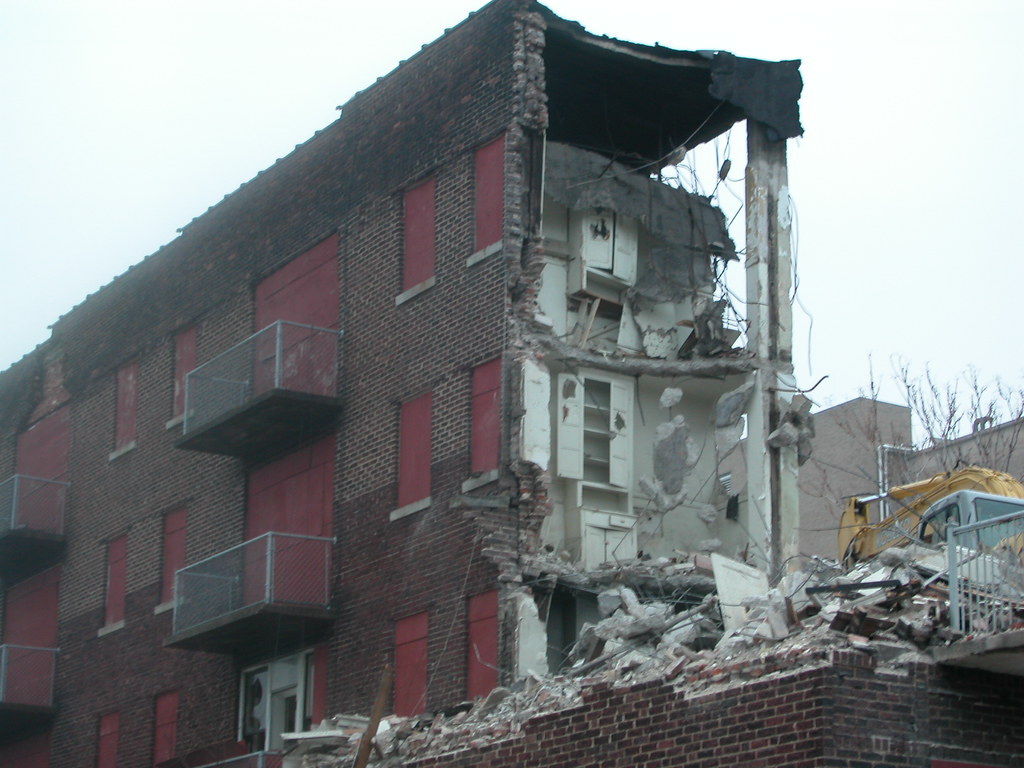
Alas, the potential for reuse in December 2007 was perhaps greater than ever. Thanks to the work of Restoration St. Louis, Steve Trampe and other developers, there finally is an apartment housing market in Midtown. These developers have seen the obvious need for off-campus housing for St. Louis University students and have rehabbed large historic buildings for housing. Two blocks from the Spring Avenue mall entrance to the SLU campus, the Central Apartments had an obvious market.
While the 3700-3800 block of Olive Street has long lost any semblance of cohesive historic character, and lies outside of the Midtown National Historic District, the block retains a few buildings and many lots the could be developed. The William Cuthbert Jones House and the former Lindell Exchange (later Wolfner memorial library) on the south side of the block were recently listed on the National Register of Historic Places. Historic rehabilitation and new construction could transform that block from its current dullness.
Built in 1916, the Central Apartments possessed an elegant front elevation adorned in the Renaissance Revival style. With a sound structure, mostly solid masonry and largely intact interiors -- revealed when exterior walls were knocked off of the building -- the building was in good shape. The building could have provided the high-density urban housing one would assume is needed to make a thriving arts and entertainment district function as a real neighborhood.
Why Grand Center did not make rehabilitation of the building a priority is a mystery. Too often, such a senseless demolition is the result of deliberate bad planning. Here, it seems the result of no planning and no deliberation whatsoever.
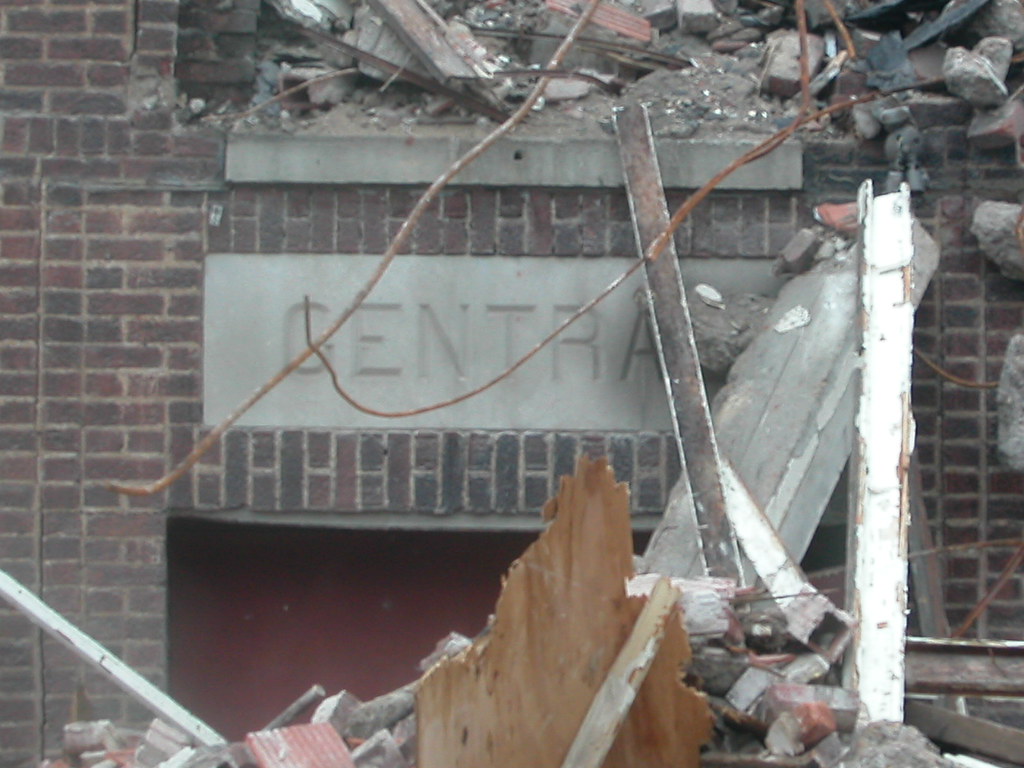
Labels:
demolition,
grand center,
lra,
midtown
Monday, December 24, 2007
Gift Basket
There are now official Board of Public Service plans for the Marti Frumhoff Memorial Garden, which will be the triangle at the intersection of Utah and Morganford. See the plans here.
Meanwhile, Steve Smith has posted his video of an August 2007 trip into the Spivey Building in downtown East St. Louis.
St. Louis Patina went in search of Edwin Lemp's Cragwold estate.
Meanwhile, Lumiere Place opened in time for the holidays. Reviews by Urban St. Louis forum members start here.
Meanwhile, Steve Smith has posted his video of an August 2007 trip into the Spivey Building in downtown East St. Louis.
St. Louis Patina went in search of Edwin Lemp's Cragwold estate.
Meanwhile, Lumiere Place opened in time for the holidays. Reviews by Urban St. Louis forum members start here.
Labels:
architecture,
east st louis,
southside,
st louis county
Friday, December 21, 2007
Just Another Vacant Building?
I don't think there is such a thing as an average run-of-the-mill vacant building in St. Louis. For instance, look at this building located at 2831 Lafayette Avenue:

On first glance, the yellow-toned plywood sheets and blue awning jump out from a nearly all-white building. Looking at the building longer, details emerge. Behind that projecting storefront is a different, older building. The building appears to be an old house. A close look brings out clues.
This two-story building has a pretty sandstone front; the large filled-in window openings must have been gorgeous when they were glazed. Underneath white paint and stucco repairs are fine carved details around the windows. The sunbursts centered over each window are impressive and typical of the finely detailed nineteenth century stone masonry we have in St. Louis. Right at the top are sill brackets, showing that the building once stood another story taller. The presence of such fine details, the use of sandstone and the style of the facade suggest a construction date in the 1880s. In fact, building permits show that this block face was built out with houses (mostly single-family and many with significant construction costs) between 1880 and 1895. There are three permits for three-story houses: in 1880, 1889 and 1894.
Owners added the storefront addition at 2831 Lafayette by the 1930s, although fire insurance maps show that the building retained its third story into the 1960s. The first floor of the building was in use a dry cleaners as soon as the storefront was finished. Apartments were above. Essentially, the building joined many others in the city located in well-to-do walking neighborhoods that changed dramatically in the early twentieth century as the upper and middle classes migrated west to quieter streets farther from downtown. The large houses of the migrating residents often were divided into rental housing or businesses; many were expanded, and altered and some were eventually demolished as new commercial uses moved into once-genteel neighborhoods. One under appreciated result of these changes was that population density increased. This building is a frank reminder of twentieth century changes in use and demographics on the near south side.
Deed research could clear up which one corresponds to this house. For now, I am glad to have given it a long look and learned that the old building tells an unexpected story. While the house has lost its third story and its original appearance, the remaining traces still provide beauty. There is no reason that future reuse of the building could not highlight the remaining traces and incorporate them into a new design. While the building is rendered ineligible for any landmark designation through loss of historic appearance, there are many futures for it beyond simply tearing it down.
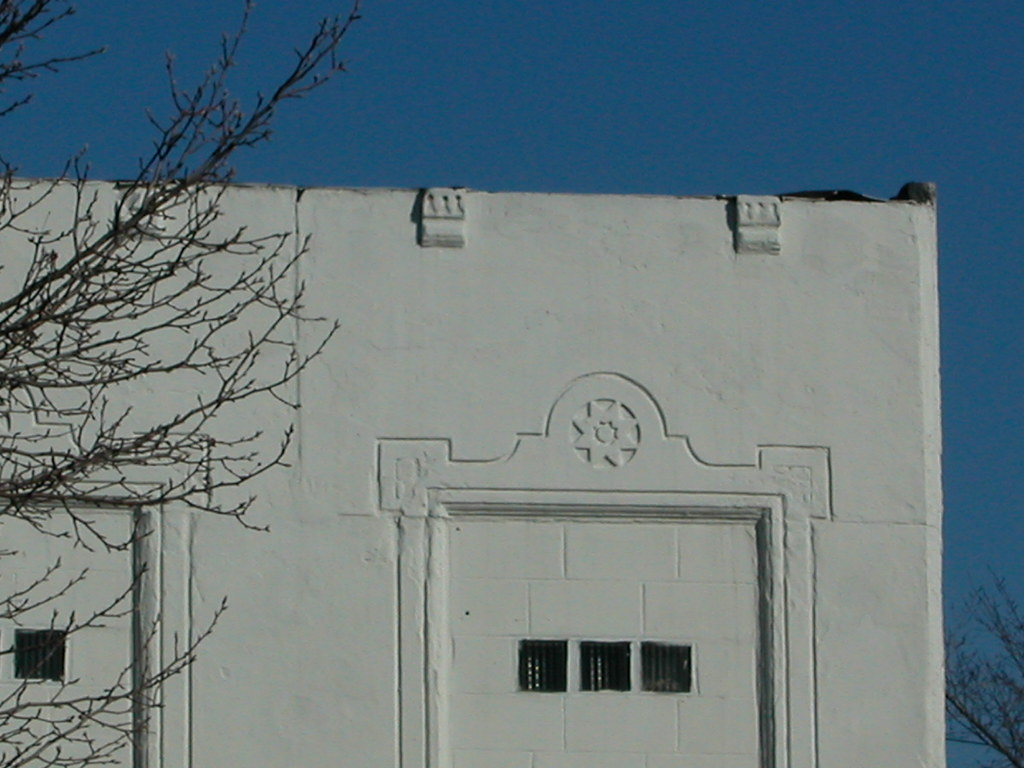
All over our city are similar old houses -- many with storefront additions, missing floors, mangled entrances and strange alterations. These are the buildings that cannot be considered contributing to historic districts but who still lend historic character to our streets. Historic rehabilitation tax credits will never be available for these buildings. Some would knock them over, because of the financial problems of rehabbing them without tax credits. Hopefully others will see that, however twisted or obscured, these buildings still have architectural potential -- and still tell the stories of their construction and show the scars of changing use. This stretch of Lafayette Avenue gains far more character from 2831 Lafayette in its current state than from the new homes of the Gate District, or the Holiday Inn.

On first glance, the yellow-toned plywood sheets and blue awning jump out from a nearly all-white building. Looking at the building longer, details emerge. Behind that projecting storefront is a different, older building. The building appears to be an old house. A close look brings out clues.
This two-story building has a pretty sandstone front; the large filled-in window openings must have been gorgeous when they were glazed. Underneath white paint and stucco repairs are fine carved details around the windows. The sunbursts centered over each window are impressive and typical of the finely detailed nineteenth century stone masonry we have in St. Louis. Right at the top are sill brackets, showing that the building once stood another story taller. The presence of such fine details, the use of sandstone and the style of the facade suggest a construction date in the 1880s. In fact, building permits show that this block face was built out with houses (mostly single-family and many with significant construction costs) between 1880 and 1895. There are three permits for three-story houses: in 1880, 1889 and 1894.
Owners added the storefront addition at 2831 Lafayette by the 1930s, although fire insurance maps show that the building retained its third story into the 1960s. The first floor of the building was in use a dry cleaners as soon as the storefront was finished. Apartments were above. Essentially, the building joined many others in the city located in well-to-do walking neighborhoods that changed dramatically in the early twentieth century as the upper and middle classes migrated west to quieter streets farther from downtown. The large houses of the migrating residents often were divided into rental housing or businesses; many were expanded, and altered and some were eventually demolished as new commercial uses moved into once-genteel neighborhoods. One under appreciated result of these changes was that population density increased. This building is a frank reminder of twentieth century changes in use and demographics on the near south side.
Deed research could clear up which one corresponds to this house. For now, I am glad to have given it a long look and learned that the old building tells an unexpected story. While the house has lost its third story and its original appearance, the remaining traces still provide beauty. There is no reason that future reuse of the building could not highlight the remaining traces and incorporate them into a new design. While the building is rendered ineligible for any landmark designation through loss of historic appearance, there are many futures for it beyond simply tearing it down.

All over our city are similar old houses -- many with storefront additions, missing floors, mangled entrances and strange alterations. These are the buildings that cannot be considered contributing to historic districts but who still lend historic character to our streets. Historic rehabilitation tax credits will never be available for these buildings. Some would knock them over, because of the financial problems of rehabbing them without tax credits. Hopefully others will see that, however twisted or obscured, these buildings still have architectural potential -- and still tell the stories of their construction and show the scars of changing use. This stretch of Lafayette Avenue gains far more character from 2831 Lafayette in its current state than from the new homes of the Gate District, or the Holiday Inn.
Wednesday, December 19, 2007
Drinks and Mortar Tomorrow

What: Drinks and Mortar
When: 7 - 10 p.m. Thursday, December 20
Where: Dapper Dan's, 410 N. Tucker Boulevard in Downtown St. Louis
What: People gathering to talk about architecture, urbanism and anything else that's on their minds.
More information here. (And here.)
Labels:
events
Monday, December 17, 2007
Rollin Stanley Departing St. Louis
Rollin Stanley, Director of Planning and Urban Design for St. Louis, is leaving after six years on the job. More at MayorSlay.com and at Urban St. Louis. Apparently, Rollin is headed to a planning job in suburban Montgomery County, Maryland. Somehow, he kept the rumor mills quiet before breaking this news; there was no chatter preceding this announcement.
Labels:
people
Friday, December 14, 2007
Not Quite the Pinnacle
My latest commentary for radio station KWMU, a review of Lumiere Place, aired this morning. Transcript is available here.
Labels:
architecture,
media
Wednesday, December 12, 2007
McGowan and Thomas Discuss Development Tonight
Tonight at St. Louis University, the Rehabbers' Club concludes its annual series of "classes" with a panel discussion on development featuring Kevin McGowan of Blu Urban (formerly of McGowan Walsh) and Sean Thomas of the Old North St. Louis Restoration Group. This is a great chance to listen and talk to people on the cutting edge of revitalizing St. Louis city. Bring questions!
Date: Wed., Dec. 12th
Time: 7:00-8:30 p.m.
Location: St. Louis University's Humanities Building, 3800 Lindell Boulevard, Room 142 [1st floor conference room]
Cost: $10 or join ReVitalize St. Louis (parent of the Rehabbers' Club) at the $20 or above level, and get this class free. Payment by cash or check only.
Other information: Parking at the Moolah Theater garage across the street is only $1/hour.
Date: Wed., Dec. 12th
Time: 7:00-8:30 p.m.
Location: St. Louis University's Humanities Building, 3800 Lindell Boulevard, Room 142 [1st floor conference room]
Cost: $10 or join ReVitalize St. Louis (parent of the Rehabbers' Club) at the $20 or above level, and get this class free. Payment by cash or check only.
Other information: Parking at the Moolah Theater garage across the street is only $1/hour.
Labels:
events
Monday, December 10, 2007
Saller Working for Missouri Coalition for Historic Preservation and Economic Development
The Missouri Coalition for Historic Preservation and Economic Development recently hired Christian Saller. Christian is a veteran of the St. Louis Development Corporation and was a candidate for alderman in the Sixth Ward earlier this year. Anyone who knows Christian knows his passion for historic preservation, extensive knowledge of the politics of development, sharp memory and kindness. I am glad to see his holding a job where his talent and passion are both put to use.
Meanwhile, the Coalition is gearing up for 2008, the tenth anniversary of the enactment of our state's historic rehabilitation tax credit. Already there are rumblings from Republican State Senator Brad Lager, who is apparently going to introduce a bill to cap the tax credit in the forthcoming legislative session. Christian and others have hard work ahead.
Meanwhile, the Coalition is gearing up for 2008, the tenth anniversary of the enactment of our state's historic rehabilitation tax credit. Already there are rumblings from Republican State Senator Brad Lager, who is apparently going to introduce a bill to cap the tax credit in the forthcoming legislative session. Christian and others have hard work ahead.
Labels:
historic preservation,
people
World Leadership Award Nice, Progress Made Great
Historic preservation has led to St. Louis winning a World Leadership Award in the category of housing. The award specifically recognizes the heroic efforts of St. Louisans in revitalizing vacant historic buildings. While Mayor Francis Slay and Planning Director Rollin Stanley went to the award ceremony in London to claim the award, it really belongs to everyone working to revitalize the city -- residents, rehabbers, developers, preservationists, architects and, I suppose, politicians.
While there are definite reasons to be skeptical about the organization that grants the awards (Steve Patterson has those reasons covered), there is no doubt that the accomplishment is very real. According to Mayor Francis Slay, more than 20,000 housing units have been rehabbed in the city since 2000. The turnaround is dramatic, and the visible results in the city rewarding to generations (including mine) who lived through darker days. While the losses continue, and politicians and urban planners sometimes seem to be the last people to get the news that historic preservation and unique character are fueling our renewal, things haven't been this good for old buildings in decades. We are making a lot of progress.
The roots of this resurgence go back to 1996 when a group of St. Louisans, with attorney Jerry Schlicter at the forefront, pushed to make historic preservation economically sensible. These folks successfully lobbied the Missouri General Assembly to enact the country's most progressive state historic rehabilitation tax credit. This credit was a boon to St. Louis and the entire state. Preservation used to be the lonely battle of historians and neighborhood activists. Now it's the common parlance of developers, realtors and bankers -- the people who control the historic buildings. For over a decade, heartbreaks have been healed. Preservationists have gladly seen many of their gloomy predictions proven wrong.
The battles continue, of course. The playing field is different in many ways. Demolition is still a problem, and historic landmark status has become a double-edged sword that cuts historic buildings that won't ever get it. North city likely will bleed buildings for the next two decades. But a preservationist now has some pretty impressive case examples of the viability of preservation. We don't need an award to reap the benefits of changed political and economic circumstances, but it sure doesn't hurt.
While there are definite reasons to be skeptical about the organization that grants the awards (Steve Patterson has those reasons covered), there is no doubt that the accomplishment is very real. According to Mayor Francis Slay, more than 20,000 housing units have been rehabbed in the city since 2000. The turnaround is dramatic, and the visible results in the city rewarding to generations (including mine) who lived through darker days. While the losses continue, and politicians and urban planners sometimes seem to be the last people to get the news that historic preservation and unique character are fueling our renewal, things haven't been this good for old buildings in decades. We are making a lot of progress.
The roots of this resurgence go back to 1996 when a group of St. Louisans, with attorney Jerry Schlicter at the forefront, pushed to make historic preservation economically sensible. These folks successfully lobbied the Missouri General Assembly to enact the country's most progressive state historic rehabilitation tax credit. This credit was a boon to St. Louis and the entire state. Preservation used to be the lonely battle of historians and neighborhood activists. Now it's the common parlance of developers, realtors and bankers -- the people who control the historic buildings. For over a decade, heartbreaks have been healed. Preservationists have gladly seen many of their gloomy predictions proven wrong.
The battles continue, of course. The playing field is different in many ways. Demolition is still a problem, and historic landmark status has become a double-edged sword that cuts historic buildings that won't ever get it. North city likely will bleed buildings for the next two decades. But a preservationist now has some pretty impressive case examples of the viability of preservation. We don't need an award to reap the benefits of changed political and economic circumstances, but it sure doesn't hurt.
Labels:
historic preservation,
mayor slay
Friday, December 7, 2007
New Fleur de Lis Looks A Little Odd
A few weeks ago, the new St. Louis University Biolab building at Grand and Chouteau avenues gained an unfortunate appendage: a large fleur de lis atop the attached tower section. While the site plan for the building is abysmal, the building itself has many redeeming qualities. Overall, Cannon Design gave the building a restrained modern sensibility -- within the constraints of St. Louis University's constant use of architecture as branding. (Such practice mars both architecture and the brand, methinks.)
At night, the fleur de lis glows blue with neon light. It is a huge distraction from the building, and clashes severely. However, there is another problem with the symbolic flower. A friend and I noted that the center crest seems a bit low, and the wings -- yes, those are wings --too wide.
Here is the sign at night:

Here is a common fleur de lis symbol:

Something seems wrong with the proportions. The sign is too short and too wide. Perhaps it emulates not our city's symbol but a popular napkin folding shape:

The alternate meanings are many. The ascot could symbolize the laboratory's formality, or maybe its adherence to the academic tradition of inquiry. The napkin symbolizes cleanliness, an important quality for a laboratory. Napkins also suggest that the laboratory is well suited to "clean up" in the field of biomedical research -- a goal of local civic leaders. Of course, wings suggest flights of inspiration and the lofty goal of developing cures for human ailments.
At night, the fleur de lis glows blue with neon light. It is a huge distraction from the building, and clashes severely. However, there is another problem with the symbolic flower. A friend and I noted that the center crest seems a bit low, and the wings -- yes, those are wings --too wide.
Here is the sign at night:

Here is a common fleur de lis symbol:

Something seems wrong with the proportions. The sign is too short and too wide. Perhaps it emulates not our city's symbol but a popular napkin folding shape:

The alternate meanings are many. The ascot could symbolize the laboratory's formality, or maybe its adherence to the academic tradition of inquiry. The napkin symbolizes cleanliness, an important quality for a laboratory. Napkins also suggest that the laboratory is well suited to "clean up" in the field of biomedical research -- a goal of local civic leaders. Of course, wings suggest flights of inspiration and the lofty goal of developing cures for human ailments.
Labels:
architecture,
signs,
southside
Hewlett Students Present Their Projects Tomorrow
Each year, freshman students in professor Bob Hansman's Hewlett City Seminar at the Washington University School of Architecture trek to the Wellston Loop area of north St. Louis. Amid some of the city's most intense urban decay, the students learn from observing conditions, listening to residents and studying the history of the area's decline. Then they devise design interventions that could transform the community, channeling residents' desires into plans for the future. This is one of the best two-way streets in town. The freshman, many from other places where conditions like those of north St. Louis are rare, are exposed to a whole new world. Residents of the community are in turn exposed to an urban design perspective their political leaders often disregard.
This fall's program is over, and the students will present the models and plans they have created this semester. The presentation is tomorrow, Saturday December 8, at Friendly Temple, 5540 Dr. Martin Luther King Drive, from 1:00 - 5:00 p.m. The event is open to the public.
This fall's program is over, and the students will present the models and plans they have created this semester. The presentation is tomorrow, Saturday December 8, at Friendly Temple, 5540 Dr. Martin Luther King Drive, from 1:00 - 5:00 p.m. The event is open to the public.
Labels:
architecture,
events,
northside,
wells-goodfellow
Wednesday, December 5, 2007
CSB Records Again Freely Available through Geo St. Louis
Citizens Service Bureau (CSB) complaints records again appear to the public on the Geo St. Louis website. Apparently, city government was strictly interpreting a newly-enacted Sunshine Act compliance ordinance sponsored by Alderman Craig Schmid (D-20th). The ordinance specifies ways in which citizens have access to public records, with an emphasis on expanding access through established city policy. (More discussion on the CSB part of the law here.) Schmid claimed his intention was to put the city into compliance with existing state laws on public records, not restrict citizen access to CSB information. Schmid opposed the city's interpretation.
I noted on November 27 that the records had become password-protected.
I noted on November 27 that the records had become password-protected.
Labels:
documentation
Tuesday, December 4, 2007
Eleven Most Endangered Places Report Online
Landmarks Association of St. Louis has published its year-end report on the city's Eleven Most Endangered Places. Read it here.
Labels:
historic preservation
Sunday, December 2, 2007
Modern Motor Hotel in Central West End Faces February Demolition

Here is the building now known as the San Luis Apartments, located at 4483 Lindell Boulevard in the Central West End. Just west of the Cathedral, the building is owned by the Archdiocese of St. Louis and used as apartments for the elderly. The Archdiocese plans to demolish the building in February for a surface parking lot despite no pressing problem with the apartments, which are generally loved by residents for their excellent location. Residents are being relocated to many different places, none of which is as transit accessible -- an important criterion for older people who do not drive.
The news of the Archdiocese's plan surprises many Central West End residents who are aghast at the idea of creating a surface parking lot facing well-traveled Lindell on the same block as the elegant Cathedral. Many are astounded that the Archdiocese would proceed to demolition without any plan for future development of the site, leaving a gaping hole for an indefinite period. The Central West End Association and Alderwoman Lyda Krewson (D-28th) have yet to make official statements on the proposed demolition. However, oppositional voices are stating to cry out. Last week, the West End Word ran a letter to the editor from STL Style's Randy Vines.
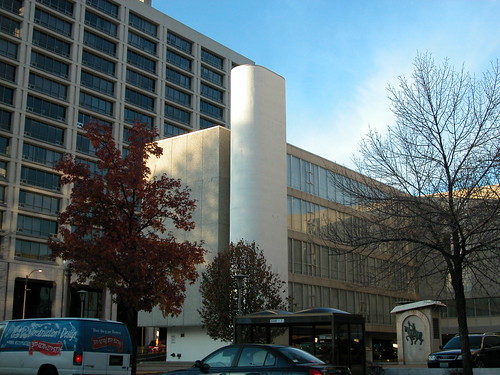
Real estate moguls Harold and Melvin Dubinsky working with Paul Kapelow took out a building permit for a motor hotel on September 25, 1961, with construction estimated at $2.75 million. New Orleans firm Colbert, Lowery, Hess & Bouderaux designed the curvilinear, E-shaped modernist hotel. On July 3, 1963 the hotel building was granted an occupancy permit and shortly afterward opened as the DeVille Motor Hotel. The hotel was part of a national boom in "motor hotels" located in urban areas. Hoteliers sought to revive urban markets by building multi-story hotels with ample covered parking on lower levels. Many had bars, including popular tiki lounges. These buildings employed modernist styles to symbolize their cleanliness and newness as well as their utility. One could park right in the hotel and avoid walking city streets carrying luggage -- no doubt a concern in the dark days of American urbanism, and perhaps still. Designers are better at hiding the parking in today's urban hotels, but the idea of integrated parking, lodging and dining remains the same.
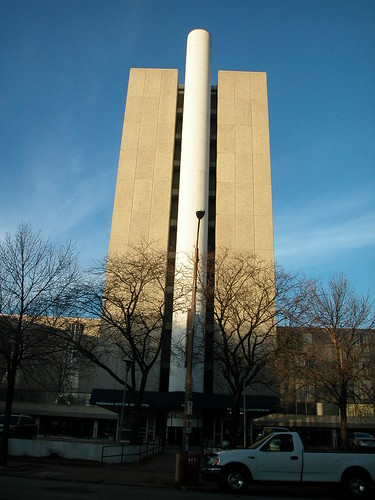
The design of the San Luis Apartments is strange and cool, if not cutting edge. The curved smooth white concrete towers cloak services while providing textural contrast to the aggregate body of each wing. The parking is recessed enough that it does not overpower the building; recessed walls on the first floor actually minimize its presence. The bays of aluminum-framed windows on the sides of the central, taller section and end of each wing are balanced by the ribbons on the inside walls of the wings. What could have been the tired bulk of a typical motor hotel -- like the Howard Johnson by the airport -- is relieved through division of the building into a series of forms of different height and footprint. This is no thoughtless slab. In fact, the modern lines interact quite well with the later and more accomplished Lindell Terrace (built in 1969 and designed by Hellmuth Obata Kassabaum) across Taylor Avenue to the west.
Unfortunately, due to recent age, the San Luis Apartments are not considered a contributing resource to the Central West End Historic District. Thus the building is not eligible for historic rehabilitation tax credits. However, the buidling is included within the boundaries of the Central West End Local Historic District so there is legally-mandated preservation review of the demolition.
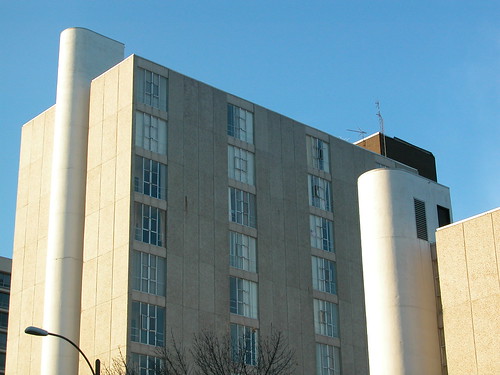
Labels:
cwe,
deville,
historic preservation,
mid-century
Subscribe to:
Posts (Atom)





